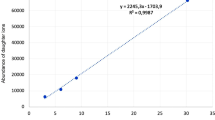Abstract
When yeasts associated withIps typographus beetles were grown in an aqueous phloem medium for two days, the main oxygenated monoterpenes produced were α-terpineol and borneol. Terpinene-4-ol, myrtenol, andtrans-pinocarveol were also found but in lesser amounts. Of the six strains used in this study,Hansenula capsulata andCandida nitratophila produced the largest amounts of oxygenated monoterpenes. Addition of α-pinene to the phloem medium generally reduced the amounts of oxygenated monoterpenes, probably because this substance is toxic to all tested yeast species. OurCandida diddensii strain seemed to be particularly sensitive to α-pinene. None of the yeast strains producedcis-verbenol,trans-verbenol, or verbenone from the medium or from added α-pinene.
Similar content being viewed by others
References
Bakke, A. 1981. Inhibition of the response inIps typographus to the aggregation pheromone; field evaluation of verbenone and ipsenol.Z. Angew. Entomol. 92:172–177.
Birgersson, G., Schlyter, F., Löfqvist, J., andBergström, G. 1984. Quantitative variation of pheromone components in the spruce bark beetleIps typographus from different attack phases.J. Chem. Ecol. 10:1029–1054.
Brand, J.M., Bracke, J.W., Markovetz, A.J., Wood, D.L., andBrowne, L.E. 1975. Production of verbenol pheromone by a bacterium isolated from bark beetles.Nature 254:136–137.
Brand, J.M., Schultz, J., Barras, S.J., Edson, L.J., Payne, T.L., andHedden, R.L. 1977. Bark-beetle pheromones enhancement ofDendroctonus frontalis (Coleoptera: Scolytidae) aggregation pheromones by yeast metabolites in laboratory bioassays.J. Chem. Ecol. 3:657–666.
Bridges, J.R., Marler, J.E., andMcSparrin, B.H. 1984. A quantitative study of the yeasts and bacteria associated with laboratory-rearedDendroctonus frontalis Zimm. (Coleopt., Scolytidae).Z. Angew. Entomol. 97:261–267.
Byers, J.A., andWood, D.L. 1981. Antibiotic-induced inhibition of pheromone synthesis in a bark beetle.Science 213:763–764.
Callaham, R.Z., andShifrine, M. 1960. The yeasts associated with bark beetles.For. Sci. 6:146–154.
Conn, J.E., Borden, J.H., Hunt, D.W.A., Holman, J., Whitney, H.S., Spanier, O.J., Pierce, H.D., Jr., andOehlschlager, A.C. 1984. Pheromone production by axenically rearedDen droctonus ponderosae and Ips paraconfusus (Coleoptera: Scolytidae).J. Chem. Ecol. 10:281–290.
DeGroot, R.C. 1972. Growth of wood-inhabiting fungi in saturated atmospheres of monoterpenoids.Mycologia 64:863–870.
Hughes, P.R. 1973.Dendroctonus: Production of pheromones and related compounds in response to host monoterpenes.Z. Angew. Entomol. 73:294–312.
Leufvén, A., andBirgersson, G. 1987. Quantitative variation of different monoterpenes around galleries ofIps typogrmphus (Coleoptera: Scolytidae) attacking Norway spruce.Can. J. Bot. 65:1038–1044.
Leufvén, A., andNehls, L. 1986. Quantification of different yeasts associated with the bark beetle,Ips typographus, during its attack on a spruce tree.Microb. Ecol. 12:2370–2376.
Leufvén, A., Bergström, G., andFalsen, E. 1984. Interconversion of verbenols and verbenone by identified yeasts isolated from the spruce bark beetleIps typographus.J. Chem. Ecol. 10:1349–1361.
Raffa, K.F., Berryman, A.A., Simasko, J., Teal, W., andWong, B.L. 1985. Effects of grand fir monoterpenes on the fir engraver,Scolytus ventralis (Coleoptera: Scolytidae), and its symbiotic fungus.Environ. Entomol. 14:552–556.
Renwick, J.A.A., Pitman, G.B., andVité, J.P. 1976. 2-Phenylethanol isolated from bark beetles.Naturwissenschaften 63:198.
Shifrine, M., andPhaff, H.J. 1956. The association of yeasts with certain bark beetles.Mycologia 48:41–55.
White, R.A., Jr., Agosin, M., Franklin, R.T., andWebb, J.W. 1980. Bark beetle pheromones: Evidence for physiological synthesis mechanisms and their ecological implications.Z. Angew. Entomol. 90:255–274.
Whitney, H.S. 1971. Association ofDendroctonus ponderosae (Coleoptera: Scolytidae) with blue stain fungi and yeasts during brood development in lodgepole pine.Can. Entomol. 103:1495–1503.
Whitney, H.S. 1982. Relationships between bark beetles and symbiotic organisms, pp. 183–211,in J.B. Mitton and K.B. Sturgeon (eds.). Bark Beetles in North American Conifers. University of Texas Press, Austin.
Author information
Authors and Affiliations
Additional information
This study was made within the project “Odour Signals for Control of Pest Insects.”
Rights and permissions
About this article
Cite this article
Leufvén, A., Bergström, G. & Falsen, E. Oxygenated monoterpenes produced by yeasts, isolated fromIps typographus (Coleoptera: Scolytidae) and grown in phloem medium. J Chem Ecol 14, 353–362 (1988). https://doi.org/10.1007/BF01022551
Received:
Accepted:
Issue Date:
DOI: https://doi.org/10.1007/BF01022551




